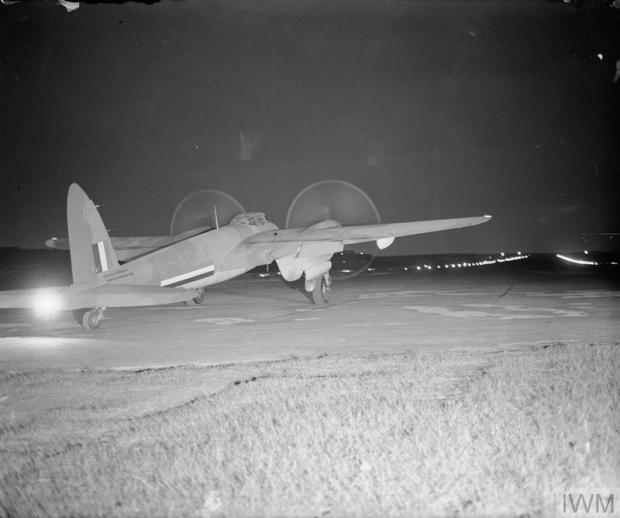BY RICHARD MADDOX
WARS ARE OFTEN FOUGHT BY GLAMOUROUS PEOPLE AND MACHINES.
They are always won by ordinary people and mundane things – like boots and ball-bearings (also known as roller bearings).
Searching IWM Collections online – as usual for something totally different – I came across the image below of a British De Havilland ‘Mosquito’.
This type of aircraft was well known as the ‘Wooden Wonder’ (the construction process used much plywood) and variants served with the RAF and Royal Navy as day and night fighters, fast light bombers and reconnaissance aircraft. It also served with the air arms of many foreign countries.
This however is an example flying with British Overseas Airways Corporation (BOAC) Fast Freight Flight, taking off from RAF Leuchars in Scotland on a night flight to Sweden.

Illuminated by a Chance Light, ‘civilianised’ Mosquito FB Mark VI, G-AGGF (formerly HJ720) of BOAC, taxies onto the flare path at RAF Leuchars, Fife, prior to a night flight to Stockholm. G-AGGF was lost on 17 August 1943 when it crashed at Invermark, killing its crew. Its remains were found on 8 September. © IWM (CH 10664)

The same image as above but digitally enhanced to show the mix of camouflage and large civilian markings. This aircraft has light undersides but others in the Flight were painted black below the camouflage upper surfaces. © IWM (CH 10664)
The BOAC’s Fast Freight Flight had an interesting and somewhat secretive history, being for passenger and freight service (as well as ‘courier flights’) to and from neutral Sweden.
These flights were ostensibly civilian operations using crews of the Merchant Air Service, many of whom had previously served in the RAF to deliver a passenger and freight service.
But the aircraft on these flights – civilianised military types such as Hudsons, Liberators and Whitleys with the aircraft’s civil registration painted large on the fuselage, upper and lower wings complete with red, white and blue underlining – flew such people and things as diverse as diplomats, intelligence agents and evading British servicemen and of course ball-bearings (1) (2).
Sweden (as a neutral country and perfectly entitled to do so) was also trading with Germany and supplying them with… ball-bearings.
And of course ball-bearings were so vital to the war economy that the US Army Air Force attacked a ball-bearing factory at Schweinfurt in southern Germany from bases in England twice in 1943, enduring high losses of both machines and men.
Although Sweden was neutral, Norway had been occupied by Germany since June 1940 and although the BOAC flights were marked as civilian aircraft they were still from a country at war with Germany and legitimate targets
Luftwaffe aircraft based in Norway were a constant danger and because of this the BOAC aircraft often flew in bad weather as this could hide them. But it didn’t always work out that way.
On 17 August 1943 the aircraft pictured above crashed near Easter Balloch in Scotland shortly after take-off, having apparently suffered an instrument malfunction (3) (4). Both crew members – Captain Louis Armstrong Wilkins (5) and his radio operator/navigator Harold Beaumont (6) – were killed.
The aircraft was missing until it was found by a gamekeeper on 8 September 1943.
It was the airline’s first Mosquito loss.

In what appears to be a staged picture a passenger (right), who has been carried in the Mosquito bomb-bay from Stockholm congratulates Captain Wilkins and his navigator on their safe arrival at RAF Leuchars. Captain Wilkins (together with his Radio Operator Harry Beaumont who MAY be in this image but is not credited) would lose his life when his aircraft crashed on 17 August 1943. Note the BOAC ‘Speedbird’ logo on the crew entry door above Wilkins’ head, the female member of BOAC or the Air Merchant Service, the faired over gun ports above the passenger’s head and the open bomb bay. © IWM (CH 20958)
FOOTNOTE
I was struck by the ‘Illuminated by a Chance light’ reference in the IWM caption and found that Chance Brothers Glassworks innovated and made a variety of glass products ranging from lighthouse optics (7) through rolled plate glass for shop fronts, to cathode ray tubes, laboratory and medical glass products, dinning ware and even souvenir ash trays and the like.
Chance Lights runway illuminators were positioned to guide approaching pilots to the threshold and the end of the runway (6).

And you think Easy Jet is bad! A passenger travelling in the bomb bay of a De Havilland Mosquito of BOAC, on the fast freight service between Leuchars, Fife and Stockholm. The bomb bay was apparently felt lined and the passenger was given a blanket – little comfort when (as on occasions it apparently did) the bomb bay opened of its own accord or the passenger had to be ditched because of German air activity. © IWM (CH 14389)
SOURCES AND FURTHER INFORMATION
(1) http://www.rafcommands.com/archive/02507.php
(2) http://www.pprune.org/aviation-history-nostalgia/383856-boac-mosquitoes.html
(3) http://www.aircrashsites-scotland.co.uk/dh-mosquito_easter-balloch.htm
(4) https://www.flickr.com/photos/stuant63/35255806052
(5) http://www.cwgc.org/find-war-dead/casualty/2459151/WILKINS,%20LOUIS%20ALFRED
(6) http://www.cwgc.org/find-war-dead/casualty/2927191/BEAUMONT,%20HAROLD
(7) http://www.rafcommands.com/archive/03370.php
My father flew as a passenger from Leuchars to Bromma in August 1944 and returned six, or so, months later. He said it was cramped and a very hairy experience.
LikeLike
Thank you Geitungur for this insight. Looking at the images I have seen I don’t doubt it! I have to ask – now you have aroused my curiosity – can you say what your father was doing at the time?
LikeLike